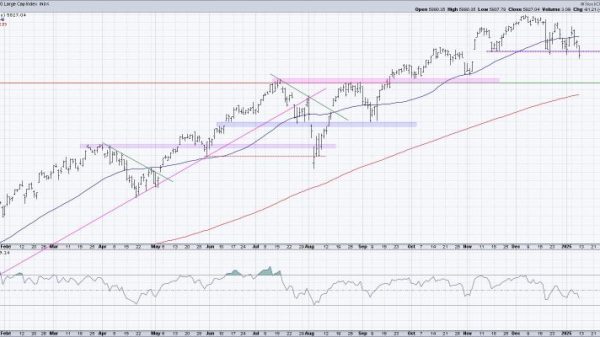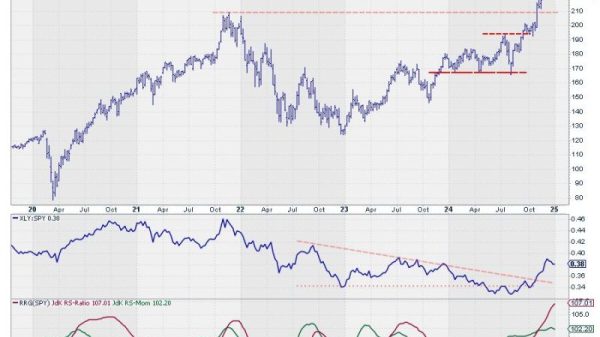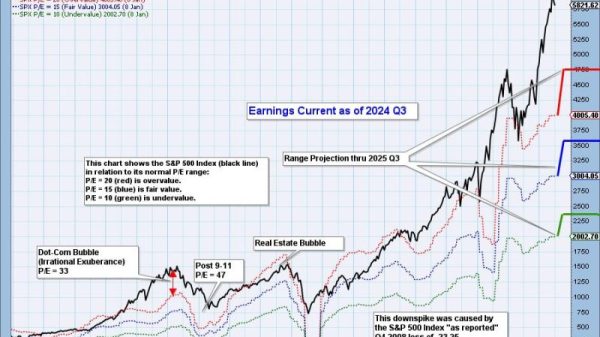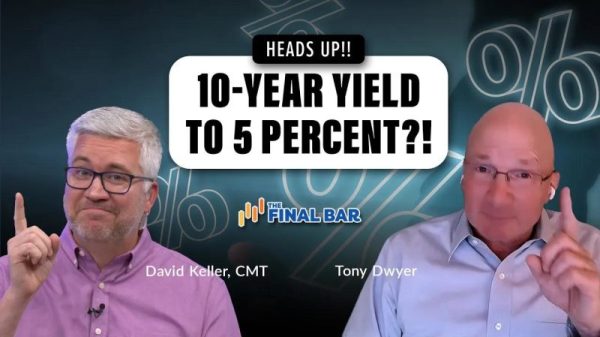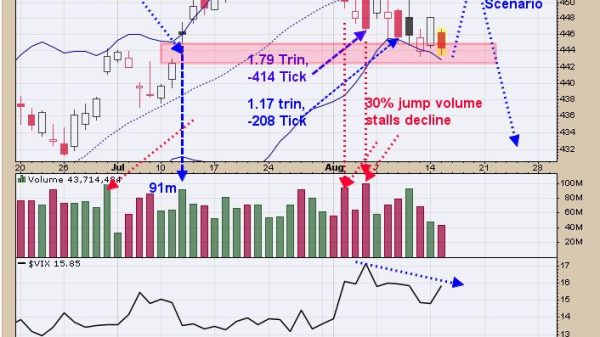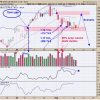In our last piece, we presented a long term/secular outlook for intermediate-term Treasuries, where we concluded that the structural break above the secular downtrend from the September 1981 high, coupled with the push above the November 2018 pivot @ 3.25%, has changed the long-term secular trend from lower (a bull market) to neutral. More work is needed to move the secular trend from neutral to bearish. In this piece, we’ll assess how the weekly chart might interact with the monthly chart, and then begin to think about how investors can react to various scenarios as they are set up over the course of the next several weeks and months.
As a warning, my analysis of the shorter perspective time frame didn’t leave me with an actionable trade or even a clear expectation for a probable outcome over the next few weeks. I think the market is ready to move away from the current congestion zone, and I suspect that the direction out of the zone will provide shorter-term traders with ample opportunity for entries. This analysis has allowed me to identify the important chart points/zones around which I will pay particular attention to behaviors and market structure, and to define appropriate trading plans.
10-Year Treasury Yield: Annual Perspective
The chart below is the yearly perspective of the 10-Year Treasury note (INDX).
Chart 1: Annual Chart of the 10-Year Treasury Yield
Note the break of the secular downtrend and the push above the 3.35% pivot. It’s worth noting that the Moving Average Convergence/Divergence (MACD) oscillator has turned higher for the first time since 1985.
Keep in mind the following points:
The basic definition of an uptrend is a market consistently defining higher highs and higher lows. For instance, a great example of a downtrend can be seen in the annual 10-year Treasury chart, where, over several decades, yields consistently made lower lows and lower highs, defining a very clear and obvious bull market (yields down/prices up).
For bonds to begin defining a secular bear (bond prices down/yields up), it will require yield to set back from a high pivot, define a higher low pivot, and subsequently make a substantive new high. From that point, you can draw tentative annual and monthly trendlines, and channel projections. You can also make Fibonacci and point-and-figure price projections. Importantly, this structure would define a secular bear and place weekly and monthly momentum harmoniously with annual momentum. I expect this transition to occur over the next 12–18 months.
The biggest question in my mind is whether last October’s 4.98% high print marked the terminal point for the bearish structure that has built since the 0.40% low. I suspect that is indeed the case and that, by mid-year, yields will be falling. However, there is also a reasonable case for one final push higher into the stronger resistance zone at around 5.25%, before subsequently setting back and defining the higher low. Given this view, the evolution of the weekly chart over the next few months becomes particularly important.
10-Year Treasury Yield: Weekly Perspective
Below is a weekly chart of the 10-Year US Treasury Yield ($TNX).
Chart 2: Weekly Chart of the 10-Year Treasury Yields Note the following points of the chart:
Bonds typically build reliable channels and trendlines, but the move from 0.40% is atypical in that a solid trendline or channel is difficult to find.
Since the move from the low doesn’t provide a solid trendline or channel, I am focused on the 2.52–3.25% (A-B) trend line. The decline from 4.98% since last October has repeatedly weakened it, and the bounce from the trendline has been very modest.
The inability of the trendline to generate selling (higher yields/lower prices) suggests that the pressure isn’t strong.
It is likely that a decline below the 3.79% pivot would likely stretch back to the 3.25% pivot, with a higher likelihood of the area around 2.65% (retracing roughly 1/2 of the 0.40% to 4.98% move).
The move from 3.79% has generally presented as a bull (lower yield/higher price) flag. Flags are usually corrective against the trend. Note that volume during the period has declined significantly (as would be expected), albeit from the extremely high volumes that developed during the move to last October’s high.
One of my favorite patterns is the “three drives to a high or low.” While this chart may technically qualify (3.48% –> 4.33% –> 4.98%) the push to 3.48% only barely qualifies, as it’s not proportional to the first two thrusts. This chart is potentially set up for a final drive higher to complete the sequence, perhaps into the strong resistance at the 5.25–5.35% area.
I will also be monitoring the price for a secondary test of 4.98%. A completed secondary test would set up for a significant bull (yield down/price up) market.
The balance of the structural evidence on the weekly chart favors lower yields, but it’s a close call and not particularly actionable from these levels.
Looking At Momentum
The multiple-screen momentum perspective below is a quick filtering method I use. Importantly, momentum is fractal (robust across time frames and markets). I prefer to derive the trend through the tape, so I only use the oscillators as a quick filter.
The chart below displays the annual, monthly, weekly, and daily charts of the 10-Year Treasury Yield. Note that on the chart, we move back to yield again.
Chart 3: Annual, Monthly, Weekly, and Daily Charts of the 10-Year Treasury Yield
An important point to remember: Rising yields = lower price.
Yearly momentum has turned toward higher yield/lower price.
Monthly momentum has turned toward lower yield/higher price. A slight negative divergence has formed, and the monthly is at odds with the yearly.
Weekly momentum is mixed/neutral, but attempting to turn to higher yield/lower price. This struggle around the zero line suggests that behaviors over the next few weeks will likely define the direction of the next 25–50 basis point movement.
I am most interested in the weekly trend (in rates, the weekly perspective is the most important), so I generally defer to the trend of one higher degree. In this case, the monthly is on a lower yield/higher price signal and is just now moving into the MACD quadrant, where significant declines (in yields) are likely to take place; Odds are better that the weekly will also turn to lower yield/higher price to be in harmony. But, again, the evidence is mixed. Sometimes, you just need to let the price action evolve before drawing a solid conclusion.
A Weekly Perspective of TLT (Bond ETF)
Chart 4: Weekly Chart of TLT
Some important points re. volume:
Since we’re viewing the iShares 20+ Year Treasury Bond Fund (TLT), we’re looking at price (a downtrend is a bear market) rather than working with yield. This is because the yield indices we are using have no reported volume. The caveat here is that, in my professional capacity, I prefer to use futures volume, as they better represent institutional-rate investors, while TLT has a distinctly retail focus.
The evidence between futures and ETF volume is conflicting. TLT showed clear signs of short-term capitulation last October, but did not display a classic selling climax.
Futures are more ambiguous, with no clear surge in volume, but price behaviors are more consistent with a selling climax.
Since the October low, the volume in general has remained quite high, and the upward progress is relatively modest. The poor result for the effort expended suggests that the market continues to run into quality supply. The same price/volume relationship is also present in futures.
Note the rapid fall in volume over the last three to four weeks as the market tilted higher. This is consistent with a bear flag or pennant.
Finally, note the volume spike (arrow) as sellers leaned into the market a few weeks ago. There are still strong-handed sellers willing to hit bids into strength.
I think the balance of evidence suggests that the market made a selling climax in October. That climax will likely hold for most of this year, but may be retested.
10-Year Treasury Yield Daily
Chart 5: Daily Chart of 10-Year Treasury Yield
Note the following points:
Seasonal Tendency. Yields tend to set significant intermediate highs early in the year before declining into mid-year. We are near the end of the bearish (yields up/prices down) annual period. This would suggest a push lower (yield down/price up).
Yields have struggled to move away from the uptrend (A/B) but generally have built a bull (prices up/yields down) flag. Now, they are being squeezed between the internal resistance (gray lateral trendline) and the A-B channel bottom. From this perspective, bears (yields higher/prices lower) have an advantage.
If the market breaks higher from this zone, where would resistance materialize? If yields breakout higher from this zone, there isn’t much resistance between 3.50% and last year’s @ 4.89% high. Above 4.89%, 5.25–5.35% is a reasonable target.
If the market breaks lower from this zone, a solid support confluence exists in the 3.23–3.30% zone. But it is more likely the 0.50–0.618 retracement zone in the 2.15–2.70% zone would be in play. This would likely come as the result of an economic recession.
The Bottom Line
The next few weeks should represent a significant juncture in the daily and potentially the weekly chart. The market has generally been consolidating over the last several months, and the pattern breakout could be meaningful. For shorter-term traders, the direction out of the consolidation will likely define the direction of travel into the fall. In other words, it is a go-with.
If yields break out higher, I will likely begin selling the breakouts of bear (prices down/yields higher) flags and will view short-term declines in yields as selling opportunities. If lower, I will likely be a buyer of bull flags and setups (yields down/prices higher) as they develop.
If the market falls away from the trendline with velocity, the first solid support there is found in the 3.79% zone.
I continue to see a not-trivial chance of one last push higher into the 5.25–5.50% zone, before beginning a major weekly and monthly perspective correction (yield down/price up) that eventually makes the higher low. And while I see an advantage to being generally bullish over the next few months (falling yields, rising prices), the analysis is tentative, with only a small near-term advantage to the trade. In my trading, I would consider it non-actionable without additional price/volume development or reasonable structure to trade against.
In deference to my macro work and business cycle work, I will be a better buyer of bullish inflections in the weekly chart over the next few months, as I fully expect a significant economic slowdown to develop into the end of the year.
Disclaimer: Shared content and posted charts are intended to be used for informational and educational purposes only. The CMT Association does not offer, and this information shall not be understood or construed as, financial advice or investment recommendations. The information provided is not a substitute for advice from an investment professional. The CMT Association does not accept liability for any financial loss or damage our audience may incur.







